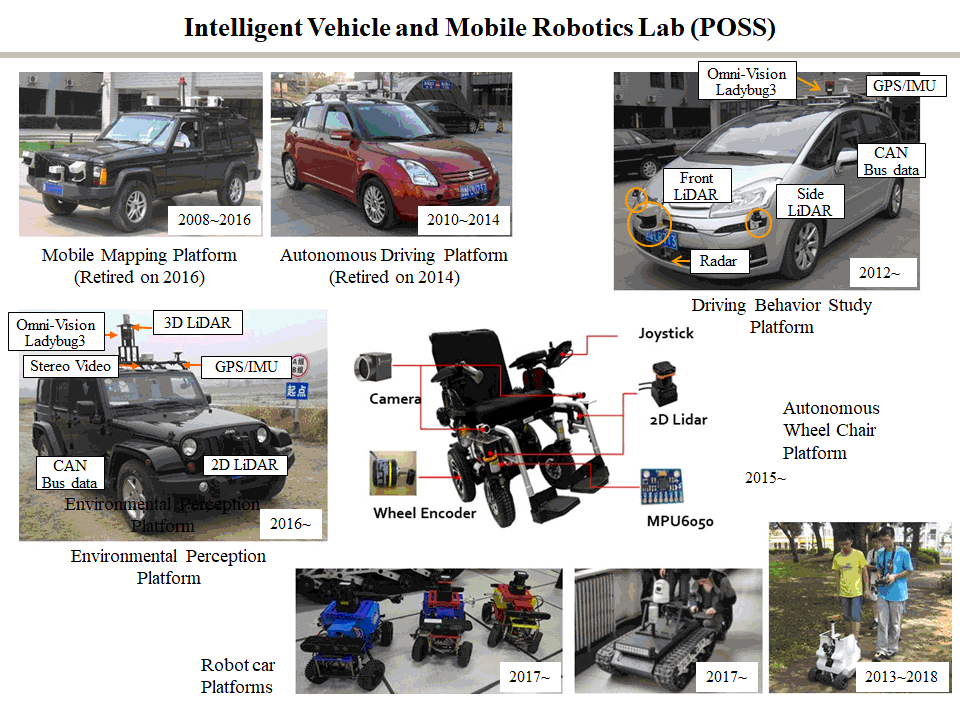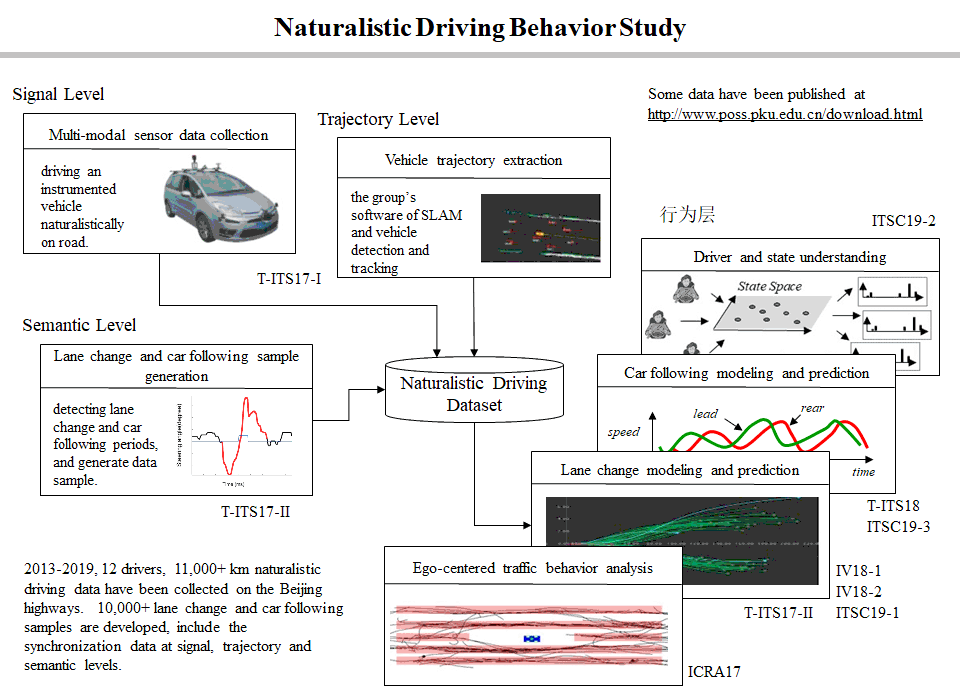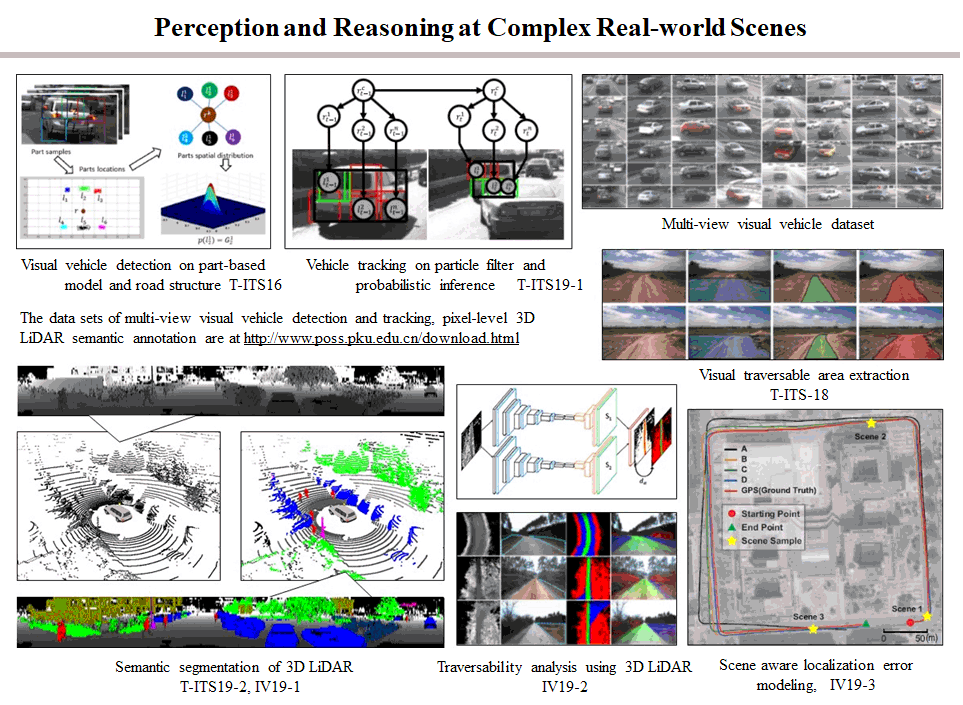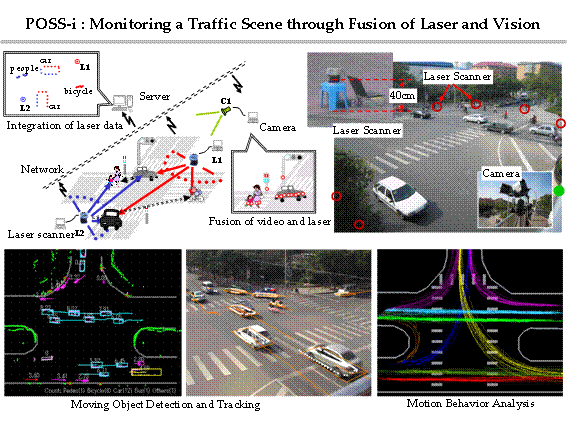Our Research
(updated at Aug. 2019)

The experimental platforms of the intelligent vehicle and mobile robots lab has been constructed since 2007. So far, it has built a laboratory with 2 real vehicles (other 2 has retired), 1 autonomous wheelchair, 1 tracked vehicle, 12 robot cars and a full range of hardware and software. On this basis, teaching of intelligent vehicle and mobile robotics is carried out since 2011, and researches on machine perception and reasoning at real-world traffic scenes is carried out for applications such as autonomous driving, smart city, intelligent transportation system and national defense security. Recent years , the research has been focused on the following three aspects: 1) aaturalistic driving behavior study, 2) perception and reasoning at complex real-world scene, 3) autonomous capability study of unmanned ground vehicles. Besides, the research of monitoring a dynamic environment through fusion of a network of laser and camera was also conducted.
Driving behavior analysis and modeling based on natural driving data collection in real world is crucial in understanding the decision-making processes and the subsequent behavior of human drivers, improving the intelligence of autonomous driving systems in complex traffic environments, achieving socialized behavior and providing personalized services etc. This research studies driving behavior through natural driving data collection using an instrumented vehicle in on the public roads in Beijing.
- Xu,D., Zhao,H., Guillemard,F., Geronimi,S., Aioun,F., Aware of Scene Vehicles - Probabilistic Modeling of Car-Following Behaviors in Real-World Traffic, IEEE Transactions on Intelligent Transportation Systems (T-ITS), 20(6) , 2136-2148, 2019.
- Zhao,H., Wang,C., Lin,Y., Guillemard,F., Geronimi,S., Aioun,F., On-road Vehicle Trajectory Collection and Scene-based Lane Change Analysis: Part I, IEEE Trans on Intelligent Transportation Systems (T-ITS), 18(1), 192-205, 2017.
- Yao,W., Zeng,Q., Lin,Y., Xu,D., Zhao,H., Guillemard,F., Geronimi,S., Aioun,F., On-road Vehicle Trajectory Collection and Scene-based Lane Change Analysis: Part II, IEEE Trans on Intelligent Transportation Systems (T-ITS), 18(1), 206-220, 2017.
Perception and reasoning is the ability of intelligent systems to construct and describe real-world features, and the basis for realizing autonomous behavior and embodying advanced intelligence. Advanced environmental perception and reasoning is essential for ADAS (Advanced Driving Assistance System) and achieving autonomous driving in complex traffic scenarios: vehicles need to use their sensors, real-timely sense road and obstacles, understand their semantic meanings, estimate location, speed, direction of the pedestrians and cars at the scene, predict their future behaviors, and plan driving routes or predict potential risks on this basis. This research studies the key techniques of perception and reasoning by collecting real world data using an instrumented vehicle at the campus, intersections, streets and highways in Beijing.
- Mei,J., Gao,B., Xu,D., Yao,W., Zhao,X., Zhao,H., Semantic Segmentation of 3D LiDAR Data in Dynamic Scene Using Semi-supervised Learning, IEEE Trans. on Intelligent Transportation Systems (T-ITS), 2019.
- Fang,Y., Wang,C., Yao,W., Zhao,X., Zhao,H., Zha,H., On-Road Vehicle Tracking Using Part-Based Particle Filter, IEEE Transactions on Intelligent Transportation Systems (T-ITS), 2019.
- Mei,J., Yu,Y., Zhao,H., Zha,H., Scene-Adaptive Off-Road Detection Using a Monocular Camera, IEEE Trans. on Intelligent Transportation Systems (T-ITS), 19(1), 242-253, 2018.
- Wang,C., Fang,Y., Zhao,H., Guo,C., Mita,S., Zha,H., Probabilistic Inference for Occluded and Multiview On-road Vehicle Detection, IEEE Trans. on Intelligent Transportation Systems (T-ITS), 17(1), 215-229, 2016.
Monitoring traffic behavior at a dynamic environment, such as an intersection, a railway station, an open square etc., collecting and analyzing scene dynamics such as motion trajectories, behavior pattern, traffic speed and statistics are of great importance in improving public security, surveillance, traffic management and signal control. In developing such intelligent systems, moving object detection and tracking, motion trajectory analysis, abnormal detection are some of the key issues, which have been studied extensively by the researchers in computer vision and ITS fields. Normally, video cameras are used, as they are less costly, mature in hardware system, easy to install, and commercially available. However, in outdoor environment, visual-based methods suffer from the problems of illumination change, occlusions, shadow, reflection etc. Especially in a cluttered environment such as an intersection in China, which is always big, complex, crowded with many kinds of moving objects, and with a mixture of different motions, traditional systems and methods face great challenges. A novel system of monitoring a dynamic environment by using a network of laser scanners and video cameras has been proposed.
- Zhao,H., Sha,J., Zhao,Y., Cui,J., Zha,H., Shibasaki,R., Detection and Tracking of Moving Objects at Intersections using a Network of Laser Scanners, IEEE Trans. Intelligent Transportation System, vol. 13, no.2, 655-670, 2012.
- Song,X., Zhao,H., Cui,J., Shao,X., Shibasaki,R., Zha,H., An Online System for Multiple Interacting Targets Tracking: Fusion of Laser and Vision, Tracking and Learning, ACM Trans. on Intelligent Systems and Technology (T-IST), 4(2), 35, 2013
- Zhao, H., Cui, J., Zha, H., Katabira, K., Shao, X., Shibasaki, R., Sensing an intersection using a network of laser scanners and video cameras, IEEE Intelligent Transportation Systems Magazine, vol.1, no.2, 31-37, 2009.



